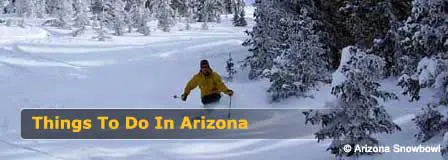Arizona's Most Interesting
Native American Indian Ruins
Ancient Indian Ruins can be found and enjoyed throughout the state of Arizona but the greatest concentration of prehistoric cliff dwellings, mud-walled structures and pueblos are in Northern Arizona in the Flagstaff and Sedona areas as well as on the Navajo Indian Reservation in Northeast Arizona.
For the convenience of both residents and Arizona tourists, following are the most visited prehistoric Indian ruins in Arizona. We've also provided links to other sites and pages within this website for more detailed information.
Central Arizona Including Phoenix Area
Unfortunately, due to poorly-planned archaeological diggings before rapid commercial building construction many of the ancient Indian community sites around the Phoenix have been destroyed or permanently covered by modern day construction. Much of the irrigation canals found in the area follow the same paths of irrigation networks that were hand-dug by prehistoric Indian civilizations.
The Pueblo Grande Museum & Cultural Park located near the Sky Harbor International Airport preserves the remnants of an ancient Hohokam Indian Village and features informative exhibits. South of Phoenix in Coolidge, Arizona, you'll find the Casa Grande Ruins National Monument. About 80 miles northeast of Phoenix in Globe Arizona, you'll find the Besh-ba-Gowah Archaeological Park where you can step back into time over 700 years ago and see one of the most complex ancient Indian communities. For more information on the Park, call (928) 425-0320.
Sedona & Verde Valley Area Ruins
Some of the more impressive ruins can be found about 90 miles north of Phoenix in the Sedona, Verde Valley area. Within an hour's drive of Sedona, you'll find not only numerous small ruin sites, but several larger sites. Just outside the town of Clarkdale, on the Verde River, stands the ruins of Tuzigoot, a Sinagua pueblo that was built atop a hill overlooking the river valley. Today the ruins are preserved as Tuzigoot National Monument, and an interpretive trail winds through the partially restored ruins.
The impressive Sinagua ruins in Verde Valley are those at Montezuma Castle National Monument. Here a five-story 12th-century cliff dwelling constructed by the Sinagua people has been preserved, and although you cannot enter the ruins themselves, there are good views from the base of the cliff. Eleven miles north lies Montezuma Well, a natural sink hole around the walls of which the Sinagua built many small dwellings. The sinkhole, which you can't even see until you are right on top of it, is an altogether unexpected sight In this dry landscape. Incidentally, neither of these sites has anything to do with the Aztec ruler Montezuma. Just a short distance northeast of Sedona, you'll discover the Ruins of Palatki which require advance reservations.
Flagstaff Area Indian Ruins
In Flagstaff you'll find Walnut Canyon National Monument, which lies just east of the city off I-40. In this 400-foot deep limestone-walled canyon, the Sinagua built many small dwellings on narrow ledges. A trail leads down into the canyon and into many of the cliff dwellings, in some of which 600-year-old handprints can still be seen in mud used to plaster the stone walls. North of Flagstaff, in the windswept high plains east of the San Francisco Peaks, lies Wupatki National Monument, which preserves several small Sinagua pueblos. Wupatki pueblo, the largest of the ruin sites, was built on the site of a natural blow hole that either blows or sucks air depending on atmospheric conditions. Wupatki is also noteworthy for its restored ball court, which is similar to the better-known ball courts built by the Aztecs and Mayans.
Navajo Nation Indian Reservation Area
Within Navajo National Monument, which is east of Lake Powell north of the Navajo Reservation, there are two large cliff dwelling sites-Keet Seel and Betatakin. These two sites, which are built beneath the overhangs of large caves, can only be reached on foot or horseback and the number of visitors allowed to the sites and the times of year that the sites can be visited are limited. It's a 5-mile round-trip hike to Betatakin and a 17-mile round-trip hike or horseback ride to Keet Seel, although there is a campground at the latter ruin site.
Other significant concentrations of cliff dwellings is in Canyon de Chelly National Monument, which is 110 miles southeast of Navajo National Monument. Although many cliff dwelling can be seen from the two rim drives within the monument, only one of these, the White House Ruins, can be visited without a Navajo guide. To get a close-up canyon-bottom look at other ruins, you'll need to either take a "shake-and-bake" tour of the canyon in one of the six-wheel-drive trucks that carries visitors deep into the canyon or hire a guide or drive your own sport utility vehicle into the canyon. You can also ride horses into the canyon or hire a hiking guide and trek in by foot.
White Mountains Area Ruins
In the town of Springerville in Arizona's White Mountains you'll find both Casa Malpais Archaeological Park and White Mountain Archaeological Center. The former is an unusual site in that some of the rooms were built into existing shallow caves to form a sort of catacomb system. The latter center is a privately owned ruin site that allows the paying public to participate in the excavation of Raven Site Ruins.
Indian Ruins In Arizona
Arizona Indian Ruins
Canyon de Chelly
Casa Grande Ruins
Montezuma Castle
Map & Directions Montezuma Castle
Montezuma Well
Palatki Indian Ruins
Pueblo Grande
Walnut Canyon
Wupatki Ruins
Most Popular Things To Do In AZ
Additional Arizona Activities















